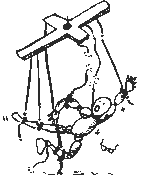
THEGREAT GABBO.(1929)
Oddball genre-hybrid. ERICH VON STROHEIM visibly relishes every word of the arch dialogue playibg mad vaudeville ventriloquist headliner, The Great Gabbo, who begins to transfer dark subconscious urges to his dummy Otto;causing complications, to say the least, when he falls in love with his assistant, Mary.(Betty Compson,wife of director James Cruze.) He's always yelling & criticizing (with some justification; after 2 years in the act she still can't walk to centre stage on cue, put a glass of water down & walk back to the wings with the tray without having an accident!). Finally Mary,although still in love with Gabbo, leaves the act, driven away by his wrath & his strange relationship with his wooden prop-pal.
Gabbo rises to the top as a Variety star, performing several strange, & (unintentionally) hilarious production numbers which will have you rolling on the floor. Originally, although not in this print, these utilised the early 'Multicolor' colour-process).
Gabbo rises to the top as a Variety star, performing several strange, & (unintentionally) hilarious production numbers which will have you rolling on the floor. Originally, although not in this print, these utilised the early 'Multicolor' colour-process).
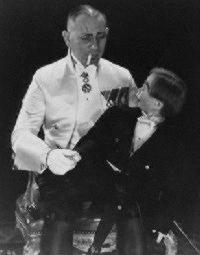
"You're MARRIED!?!?!" he exclaims in disbelief.
"Yes," says Mary, "and I love my husband."
"You LOVE him?!?"
"Yes," says Mary.
Shortly afterwards, the stage manager calls everyone to prepare for the grand finale, which soon begins without Gabbo, sulking heartbroken. in his dressing room. Halfway through a dance routine, he barges in & starts yelling to the crowd about how great he is. The manager pulls him off & reprimands him. Gabbo says he won't stand for such treatment & announces that he's finished working for such a lousy company. When he finally comes to his senses & realizes what he's done, it's too late. He has his pride! Mary is allowed by her husband to comfort Gabbo & try to talk sense into him, but Gabbo isn't listening to anyone anymore. The parting shot is of Gabbo holding his dummy, watching the workmen taking his name down off the marquee.
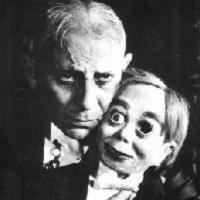
Based on the story "The Rival Dummy" by BEN HECHT - who would later pen (or co-pen) NOTHING SACRED (1937), THE FRONT PAGE (1931) & TWENTIETH CENTURY (1934) Prod Co: Sono Art/World Pictures. Prod: Henry D. Meyer, Nat Cordish. Dir James Cruze, ERICH VON STROHEIM (uncredited). Wr: BEN HECHT, Hugh Herbert. Ph: Ira H. Morgan. Prod Des. Robert E. Lee. Cost. Des. Andrani. Mus: Paul Titsworth, Lynn Cowan. Dance sequence supervis. Maurice L. Kusell. Phot. Ira H. Morgan. Mus. Dir. Howard Jackson. Cast: ERICH VON STROHEIM, Betty Compson, Donald Douglas, Marjorie 'Babe' Kane, Otto ( - the dummy, dummy). 94 mins. NFVLS.
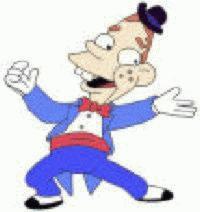
Traditional folklore takes a wry turn in this animated tale, a ludicrous cross between Pinnochio and BEING THERE (1979). Spinnolio, a carved wooden puppet noted for his "cool head" and unruffled personality - despite lacking mobility or human consciousness - grows up, gets a job, and makes a totally passive - though quite successful - go at life, until his employer decides to replace him with a computer, whereapon he is carried off by motorcycle gangs and garbagemen, showing how people use him for their own diverse purposes.
A modern-day fairy tale that smacks of the sardonic and has philosophical implications about the nature of consciousness, the work ethic, interpersonal relationships, and the citizen in society.
Prod. Co. National Film Board of Canada. Prod. Wolf Koenig, Derek Lamb. Images: Simon Leblanc, Raymond Dumas, Jacques Avoine. Anim. John F. Weldon. Mus. Art Phillips. Dir. John F. Weldon. Voice and Narr. Peter MacNeill, Janet Perlman, Henry Ramer, Neil Shee Lynn Smith, Don Arioli. 10 mins. CAC.
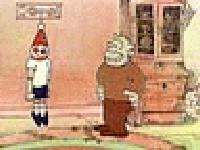
From a surreal paradise of colour, a shower of oil revives thirsty marionette model cars & creatures. This ironic little advertising film, made for Shell Motor Oil has as its protagonist the company's robot symbol. For the soundtrack, Jack Ellitt chose pieces from Holst's symphonic work The Planets. The film was originally projected in 329 cinemas & impressed the public with its colour-pallette. It also gained note for the mobility of the marionettes - alien creatures who the New York critic Jim Hoberman has compared to the mobile creations of sculptor Alexander Calder. An example of the early Gasparcolor process, towards the development of which the experimental filmmaker Oskar Fischinger had contributed. The Gasparcolor 3-colour separation printing system was invented by Dr Bela Gaspar in Belgium, 1930. Gasparcolor formed a branch in England in 1934, but their base of operations was moved from Brussels to the U.S. in 1941. Prodr: Humphrey Jennings. Dir: Len Lye. 7 mins. NFVLS.
THE PAINTER (1968)
Another in the series of highly entertaining Sebastian the Fox puppet films made right here in Melbourne a a long time ago.
Prod Co: Eltham Films. Prod: Patrick Ryan. Dir: Tim Burstall. Phot: Giorgio Mangiamele. Puppets by Peter (TINTOOKIES) Scriven. Cast: BARRY HUMPHRIES. 11 mins. NFVLS.
A young apprentice leaves his family and sets off to find work. Times are hard until he is given a table which magically spreads itself with food and wine whenever he wishes.
THE TOWN MOUSE & THE COUNTRY MOUSE
(DIE STADTMAUS UND DIE FELDMAUS) (1939)
The second film by the Diehl brothers is the well-known story of the 'The Country Mouse Visits the City Mouse'. Dir/Anim. (brothers) Ferdinand Diehl, Hermann Diehl and Paul Diehl. 23 mins. NFVLS
Prolific Nazi-era German puppet/animation filmmakers, the Diehl brothers, who had been making a variety of romantic and lyrical puppet films, were encouraged to turn their attention to folkloric subjects, which they did with such charming fables as "Eva and the Grasshopper (1928), The Brothers Grimm fairytale, The Seven Ravens (Die sieben Raben, 1937, 1953, US), Puss in Boots (Der gestiefelte Kater, 1940), and Sleeping Beauty (Dornršschen, 1942).
They also managed to break out of the cycle with a rather chilling Max and Moritz (Max und Moritz, 1941), based on Wilhelm Busch's original 19th century comic strip, from which the later "Katzenjammer Kids" was derived. The Diehls render the disgusting pranks of these two evil children in such grotesque detail that it is difficult not to read the film as a protest against the willful and petulant carnage of the Nazi overlords.
RESISTANCE AND SUBVERSION IN ANIMATED FILMS OF THE NAZI ERA:
see also:
The puppet films of the brothers Diehl. Mecki, fairy tale & Schnurren. Daniela Dietrich, Herbert Gehr, Christine Head.
The catalog contains essays over the German trickfilmers Ferdinand & Hermann Diehl, fathers of the Mecki figure. Thomas Basgier presents the brothers and their films, George Seesslen analyzes the Mecki myth and the archivist Susanne Wilk describes her work on the puppets themselves. 1994, 144 S., 140 fig., EUR 13, - ISBN 3-88799-048-X
BACK TO THE VAULT
HOME